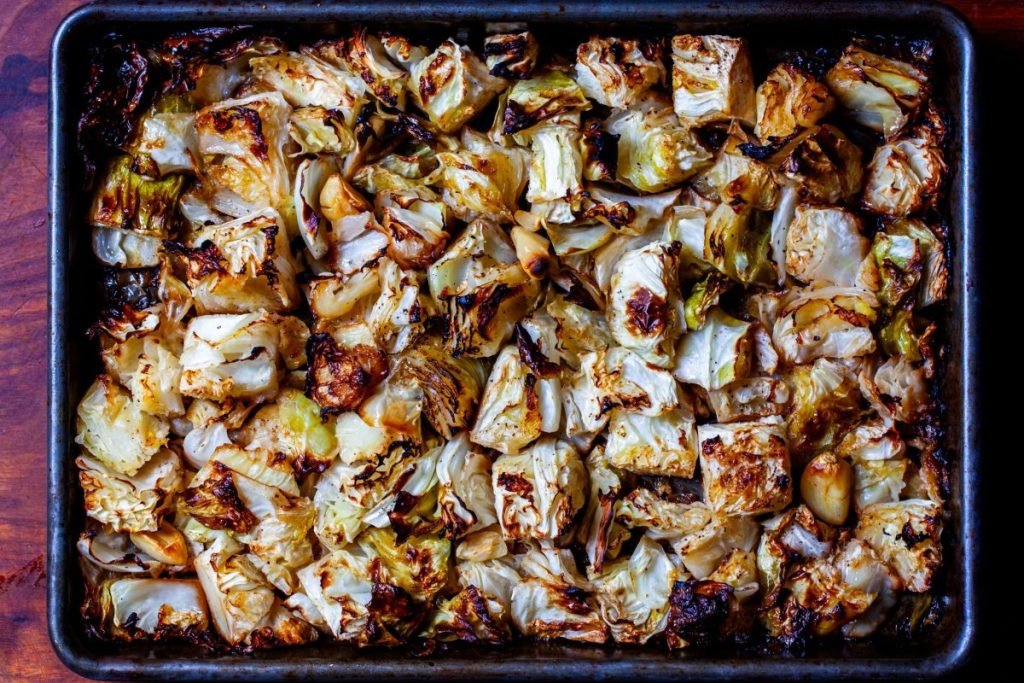This roasted cabbage dish transforms an often-overlooked vegetable into a flavor powerhouse. With its crispy edges and tender insides, this recipe, featuring green cabbage roasted to perfection with garlic and a delightful tang, will leave you wondering how you ever lived without it!
Budget Information
Total Recipe Cost: Approximately $7.50
Cost Per Serving: About $1.88 (serves 4)
Why This Recipe Works
This recipe showcases the humble green cabbage in a way that’s downright magical. You might think cabbage is just the filler at the bottom of your salad bar, but roasting it at high heat transforms it into a caramelized delight with deep, rich flavors. Add a touch of garlic and vinegar, and you’ve got a dish that elevates your dinner while keeping your wallet intact. It’s not just food; it’s an experience that proves any vegetable can shine with a little love and the right technique!
Ingredients + Optional Substitutions
Here’s what you’ll need to whip up this roasted cabbage delight (with costs based on U.S. grocery prices in 2024):
– 2 pounds green cabbage (about $1.50)
*Substitution: Savoy cabbage, if you want something with a more crinkly texture, or even Brussels sprouts for a similar flavor profile.*
– 2 tablespoons olive oil (about $0.30)
*Substitution: You can use any neutral oil like canola or grapeseed oil if that’s what you have.*
– 1 teaspoon kosher salt (about $0.05)
– 1/2 teaspoon freshly ground black pepper (about $0.05)
– 2 tablespoons unsalted butter (about $0.20)
*Substitution: For a vegan version, swap butter for a plant-based option.*
– 4 garlic cloves (about $0.30)
– 1/3 cup vegetable broth (about $0.40)
*Substitution: Chicken broth works too, but for vegan, just add more water.*
– 1/3 cup white vinegar (about $0.20)
*Substitution: Apple cider vinegar can add a different yet delightful tanginess.*
– Sea salt, to finish (about $0.02)
Step-by-Step Recipe Instructions
Step 1: Start by preheating your oven to a blistering 475°F (245°C). This high heat is crucial for getting that wonderful caramelization on the cabbage, turning it into golden goodness with crispy edges. While the oven heats up, let’s get our cabbage ready.
Step 2: Chop your cabbage into 1-to-2-inch chunks—no need to fret about making uniform sizes; nature is beautiful in its imperfections! In a large bowl, toss the cabbage pieces with olive oil, kosher salt, and black pepper, ensuring every piece is well coated. The olive oil is key here, as it lends a lovely richness that complements the cabbage’s natural sweetness.
Step 3: Line a rimmed baking sheet (about 9-by-13 inches works well) with parchment for easy cleanup, or go au naturel if you’re feeling bold! Spread the cabbage mixture evenly on the sheet, keeping it intact; those lovely layers add texture and charm. Dot the top with bits of unsalted butter—this will melt while roasting and infuse a delightful flavor into your dish. Now, put it in the oven and roast for 15 minutes. You’ll start to see some char forming, which is exactly what you want!
Step 4: Time to flip! Grab a spatula and gently turn the cabbage pieces over while introducing the smashed garlic cloves to the mix. Artfully, scatter the garlic amongst the cabbage—it will caramelize beautifully and add that sweet, garlicky flavor we all love.
Step 5: Pop it back in the oven for 15 more minutes. Don’t be alarmed if it looks a tad charred; that’s the magic happening! The edges will get crispy, and the middle will become tender. Now, it’s time to add the liquid: carefully pour in the vegetable broth and white vinegar. This step elevates everything, creating a dynamic blend of flavors.
Step 6: Return the pan to the oven for the last 15 minutes. Here, you’ll want to keep an eye on it: you’re looking for the garlic to be tender and the liquid to reduce down to a barely-there puddle—almost like a celebration of all the flavors mingling together. When it’s done, finish it off with a light sprinkle of sea salt. Alas, it’s ready, my friends—try not to devour it all straight from the pan!
Nutritional Facts
Calories: 180
Protein: 4g
Carbohydrates: 10g
Total Fats: 14g
Saturated Fat: 6g
Fiber: 3g
Sugar: 2g
Sodium: 250mg
Storage and Reheating Tips
If you have leftovers (which is rare because this is so good), let them cool completely before transferring them to an airtight container. You can store roasted cabbage in the refrigerator for up to 3 days. When it comes time to enjoy your leftovers, simply reheat them in a skillet over medium heat for a few minutes until warmed through, or pop them in the microwave for a quick fix. If you’re feeling adventurous, try adding them to a stir-fry or on top of a pizza!
Serving Suggestions
Roasted cabbage pairs beautifully with a variety of main dishes. Try serving it alongside roasted chicken or grilled fish for a well-rounded meal. For a vegetarian option, serve it over cooked quinoa or couscous, topped with a drizzle of tahini for an extra flavor boost. Alternatively, toss it into a sandwich or wrap for a crunchy and flavorful addition!
Reader Tips or Helpful Notes
Feel free to customize this recipe based on what’s in your pantry. Have some leftover veggies? Toss them in! Just remember that high heat is essential for that roast flavor, so don’t hesitate to experiment! Also, if you have a bit of cheese on hand, a sprinkling of crumbled feta or parmesan right before serving can add an incredible richness. Don’t shy away from forgetting the recipe and making this your own!
Recipe FAQs
1. Can I use other types of cabbage? Absolutely! While green cabbage shines here, you can also use savoy or even red cabbage for a twist in flavor and color.
2. Is it necessary to use garlic? Not at all! If you’re not a garlic fan, feel free to skip it, or substitute it with shallots for a milder flavor.
3. Can I prepare this dish ahead of time? While it’s best fresh from the oven, you can do the initial prep ahead and roast it right before serving. Just keep the prepared cabbage in the fridge until you’re ready to roast.
4. What should I serve with roasted cabbage? It pairs wonderfully with meats, grains, or even in a salad. Be adventurous and try it with a variety of dishes!
5. Can I freeze leftovers? While it’s best fresh, you can freeze roasted cabbage in an airtight container for up to 2 months. Just reheat directly from frozen, though the texture might be slightly softer.


